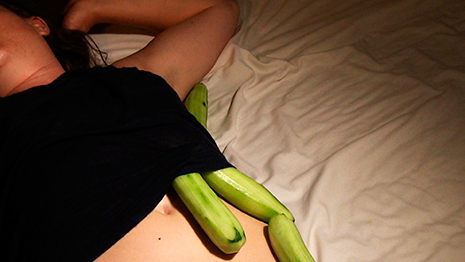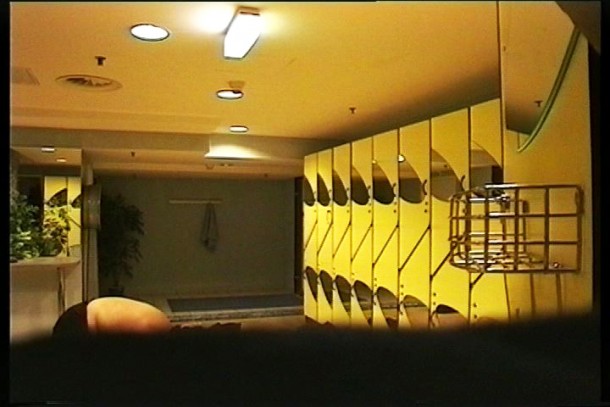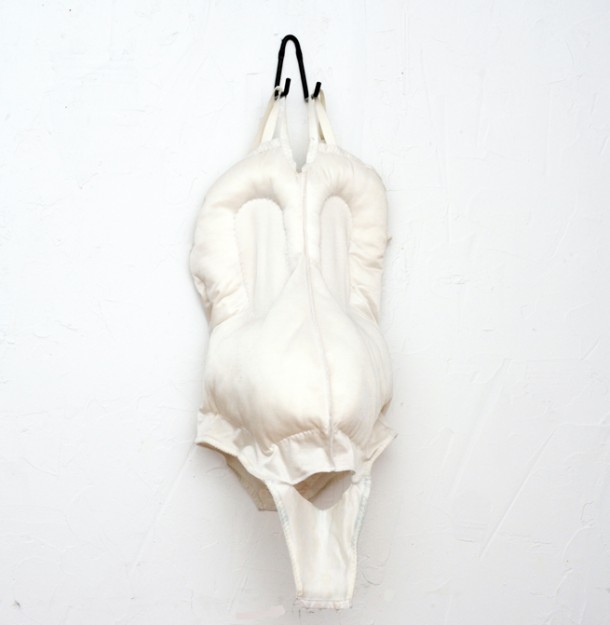Voyeur Tedium
| August 3, 2015

In the beginning of June in New York, one could see Austrian artist Maria Petschnig’s work screened twice: on one evening as part of Anthology Film Archive’s Show and Tell series, and on another at a release party at the gallery On Stellar Rays for her new career-surveying book, Maria Petschnig: Nineteen Videos 2002-2014.
Large(ish) screens and open spaces—even those of a mid-sized gallery—may not be the ideal way to watch Petschnig’s work, however, especially when surrounded by other people. This is because she makes almost gratingly intimate works on voyeurism that often resemble experimental fetish pornography; viewing them in a group or on a big screen can seem to nullify the experience. Petschnig might perform a depressing, wormlike striptease with pillows and cloth stuffed symmetrically underneath beige fishnets and a Minnie Mouse t-shirt; a video might rapidly alternate between a black screen and the artist slowly spitting into her sister’s mouth in a bathtub, or linger on a pair of feet squeezing together a tube of clay. Ideally, you maximize your voyeurism by watching her videos somewhere you’re alone but could be discovered: in one of the claustrophobic installations usually built for the purpose (a wood-paneled replica of the artist’s childhood attic, for example), or perhaps on your own computer (it might be time to admit that we watch a great deal of video work on 12-inch laptops).

Dimensions variable
Demonstrating an acute sensitivity to technology without being trapped by prepackaged aesthetics, Petschnig understands voyeurism’s current computer-drunk state and the particulars of what and who exactly is being watched. This extends beyond the comment-and-link assemblage-selves that we build on Facebook or Twitter toward the overwhelming amount of meat one sees while supposedly fleeing from meatspace. From YouTube to Pond5 to Pornhub, never before have we been able to see so many bodies move around, contort, or simply be in space in so many ways. This isn’t always enticing, the internet having seemingly exhausted its eroticism through sheer volume of material to the point where we might perform arousal more than feel aroused. Petschnig’s work often captures the sensation that something is supposed to be erotic but it isn’t. Sometimes it’s a simple denial of gratification: see Holodeck (2002/2008), the first video shown at the Anthology screening, and its series of pinhole camera-style shots of a women’s changing room. The camera peers out from behind a grate or beneath articles of clothing, its restricted field of vision obstructing any real nudity. Shots cut from one to the next before anything too risqué comes into view. The viewer perceives next to nothing, stuck simply apperceiving his or her own state of viewing.

Polyester, filling, elastic, hook
12 x 38 x 13 in
Of course, watching people change is a common voyeur trope, and Petschnig’s work becomes more interesting when she veers away from realism and towards the more fantastical ways she treats the body in what I began to think of as flesh-embellishment. Minnie (2007) begins with that amateur video motif of the performer looking directly into the camera they’ve just turned on, except the eyes filling the screen belong to Minnie Mouse, stitched into a cheap t-shirt worn by the artist. She then proceeds through a sad striptease, like a child doing drag with pillows stuffed down his or her shirt (there’s often something childish about her work, both in terms of its humor and under—over?—developed libido). In Pareidolia (2008), framed through a window, Petschnig’s torso is adorned with an assortment of fabrics, usually beige or skin-tone, cut and placed on her chest and stomach in the shapes of cartoonishly grotesque faces.
With her latest work C. (2014), which debuted at Anthology, Petschnig drifts a little bit back towards realism. Filmed with a GoPro, the 28-minute film is a lifelog of C., who one might imagine as a prototypical contemporary voyeur: male, white, in a disheveled apartment full of soft drinks and cigarette butts, browsing a webpage on a shitty computer that simply lists insults (“FUCKFACEDONKEYRAPINGWHORE; fish tits, fuck bitch w/the pretty pussy, FUCK FACE SHIT SNIFFER”). Trapped by the GoPro in C.’s head, we see him huffing and growling during an unsettling nighttime outdoor stroll during which he trails one woman on the street and surreptitiously watches another cook through a window; dressing up a cat in a wig and tinsel spiderwebs; and bellowing along to a chintzy pop techno song, replacing the lyrics with drawn out croons of “fuck you.” Outside of C.’s pale arms and legs, the only flesh we see is a photoshopped morass of penises, breasts, vaginas, and assholes that make a face, which elicits a barely audible chuckle from the protagonist.

HD video (color, sound)
5 min
Though the full half-hour can prove difficult to sit through, C.’s length turns what could have been an easy parody or inversion of GoPro’s adventure voyeurism—its slovenly loser figure replacing the camera’s usual parkour practitioners, wingsuit jumpers, and surfers—into a commentary on viewing habits. Video is increasingly cheaper and easier to capture and make, and therefore more ubiquitous. The question then becomes whether we want to watch all of what’s captured, especially when much of contemporary life consists of constantly rear-windowing each other on various digital platforms. By forcing her viewer to inhabit of the most stereotypical of voyeurs, Petschnig shows how tedious—I mean this positively, although tedium is tedium—this ouroboros can be.

